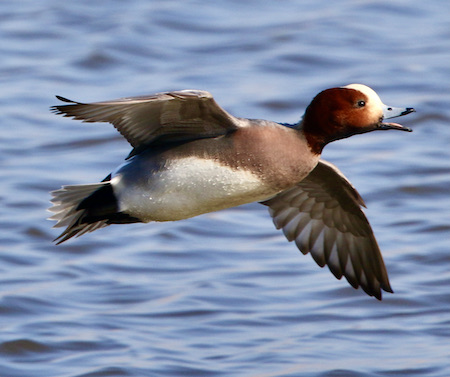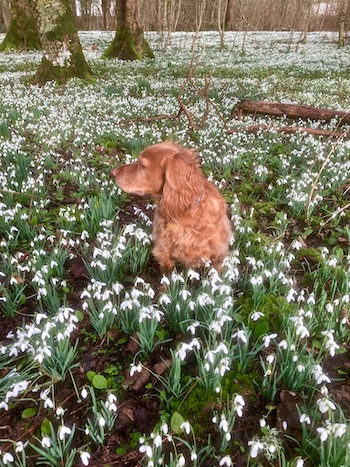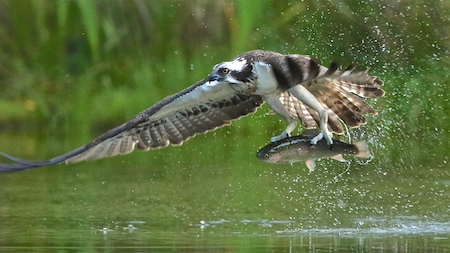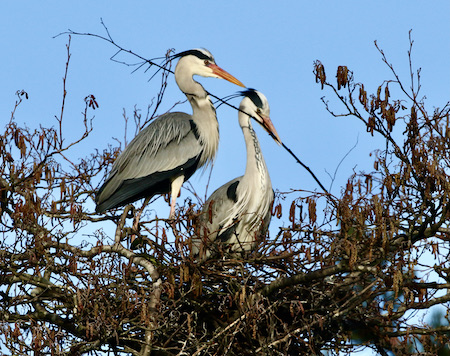March 13, 2022 at 6:26 pm
 How many times have I set off to film a certain species of bird and ended up with something else that was totally unexpected? This happened last week when I visited Yorkshire in search of Marsh Harriers and ended up with a fly-past calling Wigeon and a Buzzard doing what Marsh Harriers should be doing i.e. hunting the reed-beds for prey. An excuse for a re-visit perhaps! www.facebook.com/gordonyateswildlife
How many times have I set off to film a certain species of bird and ended up with something else that was totally unexpected? This happened last week when I visited Yorkshire in search of Marsh Harriers and ended up with a fly-past calling Wigeon and a Buzzard doing what Marsh Harriers should be doing i.e. hunting the reed-beds for prey. An excuse for a re-visit perhaps! www.facebook.com/gordonyateswildlife
February 27, 2022 at 7:44 pm
 Despite enduring three storms last week on Islay one thing did not suffer – the Snowdrops at Bridgend were as good, or even better, than ever as shown in this weeks blog.As always the attraction of Islay is that you never know what is around the next corner. We had everything from five Herons roosting together, Sea Eagles flying overhead and disturbing Greenland White-fronted Geese or Sanderling and Turnstones flying along the beach into the gale. Wild Goats, Chough, Fieldfare and of course Hen Harriers were the support acts.
Despite enduring three storms last week on Islay one thing did not suffer – the Snowdrops at Bridgend were as good, or even better, than ever as shown in this weeks blog.As always the attraction of Islay is that you never know what is around the next corner. We had everything from five Herons roosting together, Sea Eagles flying overhead and disturbing Greenland White-fronted Geese or Sanderling and Turnstones flying along the beach into the gale. Wild Goats, Chough, Fieldfare and of course Hen Harriers were the support acts.
www.facebook.com/gordonyateswildlife
February 22, 2022 at 8:03 pm
 We have just returned from eight days on Islay during which there were three named storms! While on some days no film was taken there is always a bonus from raging gales- as the forests were battered by 80mph winds the Red Deer stags came out into the open to get away from all the noise. The result was seven stags that provided some wonderful portraits in perfect light. www.facebook.com/gordonyateswildlife
We have just returned from eight days on Islay during which there were three named storms! While on some days no film was taken there is always a bonus from raging gales- as the forests were battered by 80mph winds the Red Deer stags came out into the open to get away from all the noise. The result was seven stags that provided some wonderful portraits in perfect light. www.facebook.com/gordonyateswildlife
February 12, 2022 at 6:31 pm
 Any visit to Speyside is not complete without time spent filming Ospreys as they catch trout in the numerous lochs. It is almost impossible to determine where they are going to fish and even if you guess which loch they will visit they are going to be a long way off your camera so the image you obtain will be quite small. There is a way around this but it may cost you more than one hundred pounds per day – two places stock trout in smaller lochs with permanent hides especially for the Osprey photographer.All this weeks photos were taken at one such place in Aviemore and in my view it was money well spent – there is no better experience than having an Osprey dive into the water less than thirty feet away and then rise holding an enormous trout. www.facebook.com/gordonyateswildlife
Any visit to Speyside is not complete without time spent filming Ospreys as they catch trout in the numerous lochs. It is almost impossible to determine where they are going to fish and even if you guess which loch they will visit they are going to be a long way off your camera so the image you obtain will be quite small. There is a way around this but it may cost you more than one hundred pounds per day – two places stock trout in smaller lochs with permanent hides especially for the Osprey photographer.All this weeks photos were taken at one such place in Aviemore and in my view it was money well spent – there is no better experience than having an Osprey dive into the water less than thirty feet away and then rise holding an enormous trout. www.facebook.com/gordonyateswildlife
February 6, 2022 at 6:50 pm
 There is little doubt that the best place to see Red Squirrels is the Caledonian pine forests of Speyside. They are found in virtually every forest and thankfully do not have to compete with the more dominant Grey Squirrels. If you are going to visit Speyside then make sure you have a pocketful of Hazel nuts and you will soon bring Red Squirrels within camera range. www.facebook.com/gordonyateswildlife
There is little doubt that the best place to see Red Squirrels is the Caledonian pine forests of Speyside. They are found in virtually every forest and thankfully do not have to compete with the more dominant Grey Squirrels. If you are going to visit Speyside then make sure you have a pocketful of Hazel nuts and you will soon bring Red Squirrels within camera range. www.facebook.com/gordonyateswildlife
 How many times have I set off to film a certain species of bird and ended up with something else that was totally unexpected? This happened last week when I visited Yorkshire in search of Marsh Harriers and ended up with a fly-past calling Wigeon and a Buzzard doing what Marsh Harriers should be doing i.e. hunting the reed-beds for prey. An excuse for a re-visit perhaps! www.facebook.com/gordonyateswildlife
How many times have I set off to film a certain species of bird and ended up with something else that was totally unexpected? This happened last week when I visited Yorkshire in search of Marsh Harriers and ended up with a fly-past calling Wigeon and a Buzzard doing what Marsh Harriers should be doing i.e. hunting the reed-beds for prey. An excuse for a re-visit perhaps! www.facebook.com/gordonyateswildlife

 After all the recent gales it was good to spend a few hours with my local Herons.On all but two nests the Herons were already incubating eggs. However, in an Alder tree one pair were still in the early stages of nest-building and I filmed what I was after with plenty of sticks presented by the male to the female .www.facebook.com/gordonyateswildlife
After all the recent gales it was good to spend a few hours with my local Herons.On all but two nests the Herons were already incubating eggs. However, in an Alder tree one pair were still in the early stages of nest-building and I filmed what I was after with plenty of sticks presented by the male to the female .www.facebook.com/gordonyateswildlife Despite enduring three storms last week on Islay one thing did not suffer – the Snowdrops at Bridgend were as good, or even better, than ever as shown in this weeks blog.As always the attraction of Islay is that you never know what is around the next corner. We had everything from five Herons roosting together, Sea Eagles flying overhead and disturbing Greenland White-fronted Geese or Sanderling and Turnstones flying along the beach into the gale. Wild Goats, Chough, Fieldfare and of course Hen Harriers were the support acts.
Despite enduring three storms last week on Islay one thing did not suffer – the Snowdrops at Bridgend were as good, or even better, than ever as shown in this weeks blog.As always the attraction of Islay is that you never know what is around the next corner. We had everything from five Herons roosting together, Sea Eagles flying overhead and disturbing Greenland White-fronted Geese or Sanderling and Turnstones flying along the beach into the gale. Wild Goats, Chough, Fieldfare and of course Hen Harriers were the support acts. We have just returned from eight days on Islay during which there were three named storms! While on some days no film was taken there is always a bonus from raging gales- as the forests were battered by 80mph winds the Red Deer stags came out into the open to get away from all the noise. The result was seven stags that provided some wonderful portraits in perfect light. www.facebook.com/gordonyateswildlife
We have just returned from eight days on Islay during which there were three named storms! While on some days no film was taken there is always a bonus from raging gales- as the forests were battered by 80mph winds the Red Deer stags came out into the open to get away from all the noise. The result was seven stags that provided some wonderful portraits in perfect light. www.facebook.com/gordonyateswildlife Any visit to Speyside is not complete without time spent filming Ospreys as they catch trout in the numerous lochs. It is almost impossible to determine where they are going to fish and even if you guess which loch they will visit they are going to be a long way off your camera so the image you obtain will be quite small. There is a way around this but it may cost you more than one hundred pounds per day – two places stock trout in smaller lochs with permanent hides especially for the Osprey photographer.All this weeks photos were taken at one such place in Aviemore and in my view it was money well spent – there is no better experience than having an Osprey dive into the water less than thirty feet away and then rise holding an enormous trout. www.facebook.com/gordonyateswildlife
Any visit to Speyside is not complete without time spent filming Ospreys as they catch trout in the numerous lochs. It is almost impossible to determine where they are going to fish and even if you guess which loch they will visit they are going to be a long way off your camera so the image you obtain will be quite small. There is a way around this but it may cost you more than one hundred pounds per day – two places stock trout in smaller lochs with permanent hides especially for the Osprey photographer.All this weeks photos were taken at one such place in Aviemore and in my view it was money well spent – there is no better experience than having an Osprey dive into the water less than thirty feet away and then rise holding an enormous trout. www.facebook.com/gordonyateswildlife There is little doubt that the best place to see Red Squirrels is the Caledonian pine forests of Speyside. They are found in virtually every forest and thankfully do not have to compete with the more dominant Grey Squirrels. If you are going to visit Speyside then make sure you have a pocketful of Hazel nuts and you will soon bring Red Squirrels within camera range. www.facebook.com/gordonyateswildlife
There is little doubt that the best place to see Red Squirrels is the Caledonian pine forests of Speyside. They are found in virtually every forest and thankfully do not have to compete with the more dominant Grey Squirrels. If you are going to visit Speyside then make sure you have a pocketful of Hazel nuts and you will soon bring Red Squirrels within camera range. www.facebook.com/gordonyateswildlife